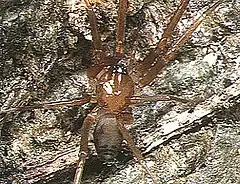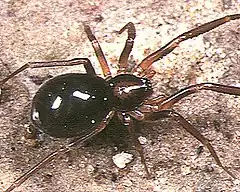Grandilithus lynx
Grandilithus lynx est une espèce d'araignées aranéomorphes de la famille des Phrurolithidae[1].
Grandilithus lynx

Grandilithus lynx ♀
- Phrurolithus lynx Kamura, 1994
Distribution
Cette espèce se rencontre au Japon dans l'archipel Nansei et à Taïwan[1] - [2].
Description

Grandilithus lynx ♂

Grandilithus lynx ♀
Le mâle holotype mesure 2,85 mm et la femelle paratype 3,90 mm[3].
Systématique et taxinomie
Cette espèce a été décrite sous le protonyme Phrurolithus lynx par Kamura en 1994. Elle est placée dans le genre Otacilia par Deeleman-Reinhold en 2001[4] puis dans le genre Grandilithus par Liu, Li, Zhang, Ying, Meng, Fei, Li, Xiao et Xu en 2022[5].
Publication originale
- Kamura, 1994 : « Two new species of the genus Phrurolithus (Araneae: Clubionidae) from Iriomotejima Island, southwest Japan. » Acta Arachnologica, vol. 43, no 2, p. 163-168 (texte intégral).
Liens externes
- (en) Référence Animal Diversity Web : Otacilia lynx (consulté le )
- (en) Référence BioLib : Otacilia lynx (Kamura, 1994) (consulté le )
- (en) Référence Catalogue of Life : Grandilithus lynx (Kamura, 1994) (synonymie) (consulté le )
- (fr+en) Référence EOL : Otacilia lynx (Kamura 1994) (consulté le )
- (fr+en) Référence GBIF : Otacilia lynx (Kamura, 1994) (consulté le )
- (fr+en) Référence ITIS : Otacilia lynx (Kamura, 1994) (consulté le )
- (en) Référence NCBI : Otacilia lynx (Kamura, 1994) (taxons inclus) (consulté le )
- (en) Référence World Spider Catalog : Grandilithus lynx (Kamura, 1994) dans la famille Phrurolithidae +base de données (consulté le )
Notes et références
- WSC, consulté lors d'une mise à jour du lien externe
- Kamura, 2005 : « Spiders of the genus Otacilia (Araneae: Corinnidae) from Japan. » Acta Arachnologica, vol. 53, no 2, p. 87-92 (texte intégral).
- Kamura, 1994 : « Two new species of the genus Phrurolithus (Araneae: Clubionidae) from Iriomotejima Island, southwest Japan. » Acta Arachnologica, vol. 43, no 2, p. 163-168 (texte intégral).
- Deeleman-Reinhold, 2001 : Forest spiders of South East Asia: with a revision of the sac and ground spiders (Araneae: Clubionidae, Corinnidae, Liocranidae, Gnaphosidae, Prodidomidae and Trochanterriidae. Brill, Leiden, p. 1-591.
- Liu, Li, Zhang, Ying, Meng, Fei, Li, Xiao & Xu, 2022 : « Unknown species from China: the case of phrurolithid spiders (Araneae, Phrurolithidae). » Zoological Research, vol. 43, no 3, p. 352-355, Suppl. I : 5 p., Suppl. II : p. I-CCXX (texte intégral).
Cet article est issu de wikipedia. Text licence: CC BY-SA 4.0, Des conditions supplémentaires peuvent s’appliquer aux fichiers multimédias.